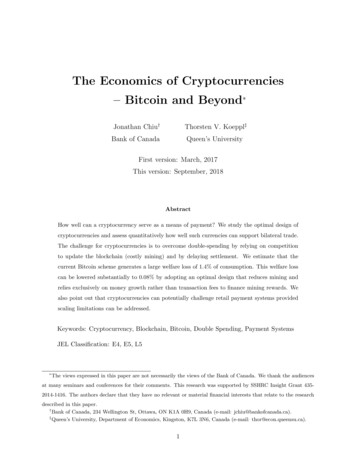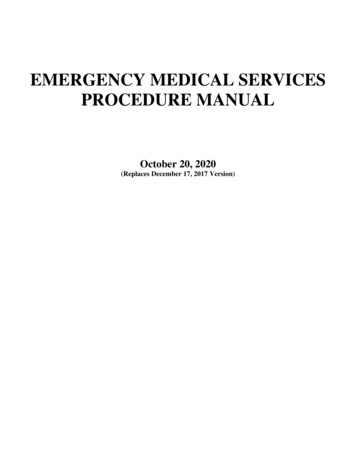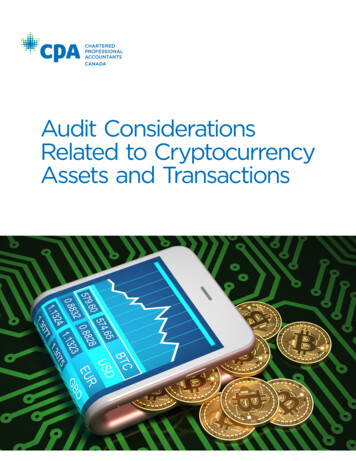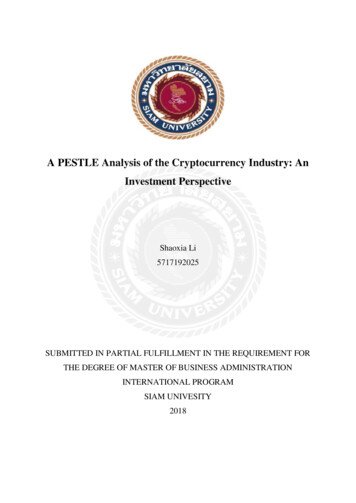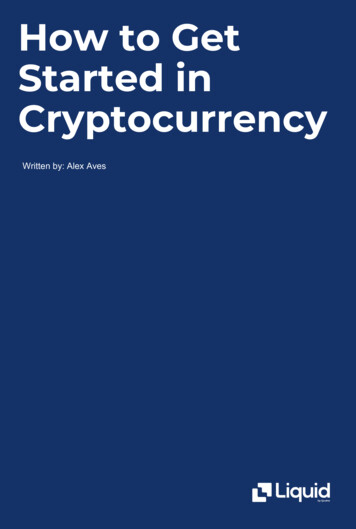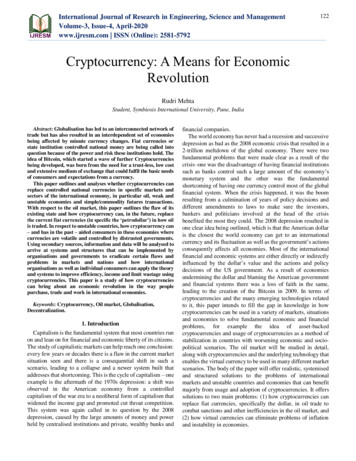
Transcription
International Journal of Research in Engineering, Science and ManagementVolume-3, Issue-4, April-2020www.ijresm.com ISSN (Online): 2581-5792122Cryptocurrency: A Means for EconomicRevolutionRudri MehtaStudent, Symbiosis International University, Pune, IndiaAbstract: Globalisation has led to an interconnected network oftrade but has also resulted in an interdependent set of economiesbeing affected by minute currency changes. Fiat currencies orstate institution controlled national money are being called intoquestion because of the power and risk these institutions hold. Theidea of Bitcoin, which started a wave of further Cryptocurrenciesbeing developed, was born from the need for a trust-less, low costand extensive medium of exchange that could fulfil the basic needsof consumers and expectations from a currency.This paper outlines and analyses whether cryptocurrencies canreplace controlled national currencies in specific markets andsectors of the international economy, in particular oil, weak andunstable economies and simple/commodity futures transactions.With respect to the oil market, this paper outlines the flaw of itsexisting state and how cryptocurrency can, in the future, replacethe current fiat currencies (in specific the ‘petrodollar’) in how oilis traded. In respect to unstable countries, how cryptocurrency can– and has in the past – aided consumers in these economies wherecurrencies are volatile and controlled by distrusted governments.Using secondary sources, information and data will be analysed toarrive at systems and structures that can be implemented byorganisations and governments to eradicate certain flaws andproblems in markets and nations and how internationalorganisations as well as individual consumers can apply the theoryand systems to improve efficiency, income and limit wastage usingcryptocurrencies. This paper is a study of how cryptocurrenciescan bring about an economic revolution in the way peoplepurchase, trade and work in international economies.Keywords: Cryptocurrency, Oil market, Globalisation,Decentralization.1. IntroductionCapitalism is the fundamental system that most countries runon and lean on for financial and economic liberty of its citizens.The study of capitalistic markets can help reach one conclusion:every few years or decades there is a flaw in the current marketsituation seen and there is a consequential shift in such ascenario, leading to a collapse and a newer system built thataddresses that shortcoming. This is the cycle of capitalism – oneexample is the aftermath of the 1970s depression: a shift wasobserved in the American economy from a controlledcapitalism of the war era to a neoliberal form of capitalism thatwidened the income gap and promoted cut throat competition.This system was again called in to question by the 2008depression, caused by the large amounts of money and powerheld by centralised institutions and private, wealthy banks andfinancial companies.The world economy has never had a recession and successivedepression as bad as the 2008 economic crisis that resulted in a2-trillion meltdown of the global economy. There were twofundamental problems that were made clear as a result of thecrisis–one was the disadvantage of having financial institutionssuch as banks control such a large amount of the economy’smonetary system and the other was the fundamentalshortcoming of having one currency control most of the globalfinancial system. When the crisis happened, it was the boomresulting from a culmination of years of policy decisions anddifferent amendments to laws to make sure the investors,bankers and politicians involved at the head of the crisisbenefited the most they could. The 2008 depression resulted inone clear idea being outlined, which is that the American dollaris the closest the world economy can get to an internationalcurrency and its fluctuation as well as the government’s actionsconsequently affects all economies. Most of the internationalfinancial and economic systems are either directly or indirectlyinfluenced by the dollar’s value and the actions and policydecisions of the US government. As a result of economiesundermining the dollar and blaming the American governmentand financial systems there was a loss of faith in the same,leading to the creation of the Bitcoin in 2009. In terms ofcryptocurrencies and the many emerging technologies relatedto it, this paper intends to fill the gap in knowledge in howcryptocurrencies can be used in a variety of markets, situationsand economies to solve fundamental economic and financialproblems, for example the idea of asset-backedcryptocurrencies and usage of cryptocurrencies as a method ofstabilization in countries with worsening economic and sociopolitical scenarios. The oil market will be studied in detail,along with cryptocurrencies and the underlying technology thatenables the virtual currency to be used in many different marketscenarios. The body of the paper will offer realistic, systemisedand structured solutions to the problems of internationalmarkets and unstable countries and economies that can benefitmajorly from usage and adoption of cryptocurrencies. It offerssolutions to two main problems: (1) how cryptocurrencies canreplace fiat currencies, specifically the dollar, in oil trade tocombat sanctions and other inefficiencies in the oil market, and(2) how virtual currencies can eliminate problems of inflationand instability in economies.
International Journal of Research in Engineering, Science and ManagementVolume-3, Issue-4, April-2020www.ijresm.com ISSN (Online): 2581-57922. Literature ReviewA. CryptocurrencyCryptocurrency refers to a digital currency in whichencryption techniques are used to regulate the generation ofunits of currency, and verify the transfer of funds, operatingindependently of a central bank or any other over viewingfinancial body. Cryptocurrency was an idea born out of thehardships of fiat currencies, more specifically the dollar, withBitcoin being the first ever paperless, trust-less money systemcreated by Satoshi Nakamoto – “What is needed is an electronicpayment system based on cryptographic proof instead of trust,allowing any two willing parties to transact directly with eachother without the need for a trusted third party.” (Nakamoto,2009).The concept of Bitcoin and by and large all Cryptocurrenciesis based on creating a system of payment that can be used acrossindustries and markets as well as a method of replacement offiat currencies. Bitcoin, Ethereum, ripple and most other majormarket cap Cryptocurrencies are based on blockchaintechnology, which is a chain of signatures of the transactionhistory of Bitcoin that builds in volume as more transactionstake place; each blockchain file has a private and public keyaccess to it, which makes the software harder to hack or damage(Turpin, 2014). The blockchain is the core of thecryptocurrency system as it is transparent and clear since youcan see every transaction in the public records, which is a fullproof and safe way to keep cryptocurrency records. There are afinite number of most Cryptocurrencies, and the limited numberprevents artificial inflation or fluctuation. The process ofmining uses large amounts of electricity and special, wellequipped CPUs that aid in the solving of complex mathematicalequations, which generates bitcoins (Hileman and Rauchs,2017).Fig. 1. Cryptocurrency Price Fluctuations(Source: Turtle BC, Market Analysis)Bitcoin accounts for up to 86% of the total market value ofall Cryptocurrencies. Other major Cryptocurrencies are variedin structure and processes yet have around the same uses. Allhave different volatilities and fluctuations in value due tomarket and value changes. Fig. 1, shows the varied volatilitiesof different Cryptocurrencies like Bitcoin and Ethereum that allfluctuate in various speeds and amounts due to changing marketconditions. Ripple, for example, is a peer-to-peer cashlesssystem of exchange for all Cryptocurrencies that uses gatewayto make transactions and has a cryptocurrency of its own that is123based on blockchain and is used more by banks and financialinstitutions, therefore known as the banker’s coin – it has majorscope in the financial industry. Another major currency laudedand used widely by the crypto community is Ethereum, or ether,that operates on a separate blockchain design. It is less volatile,more multi-functional and connected to the trade of preciousmetals (Liu, 2018).Cryptocurrency, as complex a concept it is, is widely usedand revered in financial markets consisting of both experiencedinvestors and citizens of countries that want a way out ofspending on fiat currencies. Many global consumers seeCryptocurrencies as a hedge against inflation since the numberof Cryptocurrencies of each kind is mathematically limited incirculation. The Bitcoin ‘community’ monitors andtheoretically tracks the various transactions on the Bitcoinblockchain, a system known as peer-to-peer and fullytrustworthy. Since a finite number of bitcoins can exist, it ishard to manipulate or otherwise fraudulently use bitcoins (J.K.Darlington, 2014).Fig. 2. 30-day comparative realised volatility(Source: Bloomberg, World Gold Council)When it comes to the question of the volatility ofCryptocurrencies, there is ample evidence to support the factthat they fluctuate more frequently and more violently thanother traditional assets and fiat currencies in global markets.Bitcoin in specific is very sensitive to price changes as its priceis connected to demand for the currency - which is alsodetermined by aspects such as weekly average Google searchesof Bitcoin- as well as the total trading of Bitcoin done in aspecific period of time (B. Turpin, 2014). This sensitivity inprices leads to a currency vulnerable to changes but also onethat is flexible and easily adaptable to existing global systemsand structures.B. Cryptocurrency – poverty and instabilityThere are various fundamental factors that are wrong withexisting financial systems around the globe that have beenoperating the same way for decades on an end. With changingtechnology and newer innovations these factors have emergedas problems that need to be solved, especially in times ofpolitical and economic turmoil. Cryptocurrency was createdwith the specific problem of no trust-less transaction system
International Journal of Research in Engineering, Science and ManagementVolume-3, Issue-4, April-2020www.ijresm.com ISSN (Online): 2581-5792existing in mind and a solution required for it (Nakamoto,2009). To make financial transactions implies a part of theuser’s income being taken as a transactional fee – credit cardcompanies take cuts from transactions to the tune of around 48billion a year. Companies like PayPal dominate the financialsector with the innovation in technology and transactionalsafety. The company reported a figure of 4.96 billion revenuein the 4th quarter of 2019 (PayPal, 2019) which in itself is anindicator of the rapidly changing scenario of payments and thefurther need for innovative financial instruments such ascryptocurrency.There are various difficulties Cryptocurrencies face withrespect to becoming a viable currency option, such as technicalissues in the blockchain technology, acceptability andregulatory problems, and as such will not be a commoncurrency in the near future. However, Cryptocurrencies withwide usage, popularity, strong structures and transparency likeRipple, Ethereum and Bitcoin are all viable financial tools thatcan be used by countries to pull their populations out of povertyand by citizens in politically, economically and geographicallyunstable countries.Economists such as Milton Friedman and various prominentbankers across the finance industry, such as William Blair, havecontinually criticised the fundamentals of the Federal Reserveand its excessive control on the central currency, the Americandollar, and have supported the existence of the trust-less, centralmethod of exchange that is cryptocurrency. It is not only acheap payment system but also means a way for families inpoverty to own property, which is the biggest factor of creationof wealth, and secure their futures without dependence on thegovernment and a politically influenced financial system.Another benefit of Cryptocurrencies, in specific Bitcoin, is thatthey are largely immune to hyperinflation – paper money iscontrolled in supply by governments which give institutions thefree reign to increase the physical supply of money during timesof economic recession (Hanke and Kwok, 2009).Many countries have often been the bearers of backlash dueto volatile currencies that fluctuate for many reasons and leavetheir citizens at an uncertain state. For example, Zimbabwe’sskyrocketing hyperinflation hurt the country’s financial,economic and international position, leaving the citizens at aloss of the value of the currencies they held. Similarly, Brazil’srapidly fluctuating real has resulted in the citizens of the countryinvesting in cryptocurrency, specifically bitcoin, which acts asan effective hedge against rapidly fluctuating fiat currencies.Similar to Brazil, there has been a spike in interest towardscryptocurrency in countries in the same state, such asArgentina, Venezuela, and Nicaragua (Southurst, 2014).Bitcoin, Ethereum, Ripple and many other popularcryptocurrencies can pull citizens out of a disrupted financialstate they may be in due to turbulent governments, shakyforeign policies and rampant corruption. Trading and investingin cryptocurrencies can hedge people from the damage volatilecurrencies can do, open up international markets accessible124through virtual currencies and allow for safe transactions on alarge scale (J.K. Darlington, 2014).C. Oil and the DollarThe international oil market is a complex structure consistingof the buyers, producers and traders of one of the most valuablecommodities of the modern day global market, crude oil. Thismarket is dictated by forces of demand and supply, thespeculations of traders, actions of the OPEC and thefluctuations of the U.S. dollar, the currency it is priced in. Inshort, exogenous - external political, geographic and economicaffects in OPEC countries - and endogenous - internalinvestment and demand-supply shocks and changes in the oilmarket - factors affect the oil market (A Structural Model of theWorld Oil Market, Oxford institute for Energy Studies, 2017).The wide usage and supply for oil is the fundamental reasonfor its status as an energy source. By 2006, the oil market madeup for 13% of the total global commodity trade; an estimated 4 Billion worth of oil is traded per day according to a 2008United Nations report (J.L. Smith, 2009). The many grades ofcrude oil are a part of the complex marketplace that consists ofalmost 50 oil rich countries as producers of oil and majoreconomies such as Japan, China and the U.S. being largeconsumers. The complexity, uncertainty and reach of the oilmarket are the reasons for its effect on most economies andstock exchanges globally. Events such as the 1973 OPEC oilprice shock have proved that there is a large political aspect tothe vulnerable and fragile oil market. The 1973 crisis resultedin a major fluctuation seen in stock exchanges, nationalexchange rates and growth rates of economies (Dees, et al.,2004). The reason was President Richard Nixon’s action toremove the dollar from the gold standard in 1971 and its variousrepercussions on the global economy.Fig. 3. Historical prices of Crude oil and factors responsible for fluctuation(1861-2014)(Source: BP Statistical Review of World Energy 2015)There are various factors that adversely affect the prices ofoil as outlined – this includes the presence, actions andmonopolising of OPEC, speculation and the value of the dollarthat rapidly fluctuates and inadvertently drives similarbehaviour in oil prices. The prices, peaks and drops shownabove are ones due to global events that have either disturbedthe demand or supply of oil, but also due to speculation on a fallin value before/in anticipation of fluctuations in prices.
International Journal of Research in Engineering, Science and ManagementVolume-3, Issue-4, April-2020www.ijresm.com ISSN (Online): 2581-5792Speculation in oil is the economic trading of oil in the futuresmarket; that is, for future rather than current consumption andusually barring actual physical ownership of oil barrels(Fattouh, et al., 2012). Some literature supports the traditionalviewpoint that speculation in oil markets, especially afterincreased financialization and deregulation of markets, hascaused unnecessary inflation of the essential commodity’s priceand that major institutions use these prices to hedge againstinvestment risks and complex financial instruments that effecteveryday oil prices. The Dodd-Frank Wall Street reform wasintroduced on the basis of increased speculation driving pricesand creating a bubble like expansion in the 2008 crisis,demanding increased transparency in hedging and trading toprevent oil price run ups (Sornette, et al., 2009). Yet otherliterature argues that speculation in oil trade and a highly liquidmarket reduces the risk of hedging, allows for integratedfinancial markets and greater trade and reduced costs acrossgeographically distanced oil markets (B Fattouh, 2008).Speculation is therefore a complex factor in oil markets – onone hand it helps reflect the state of the global economy andaccordingly adjusts prices and demand but also artificiallydrives up oil prices and leaves the commodity open forspeculative manipulation, adversely affecting countriesdependant on oil trade for essential revenue.Another big factor of the oil market, specifically with thedollar, is the use of economic sanctions by the AmericanGovernment against other countries to achieve political andnational security objectives that often compel countries to lookfor alternates to the dollar. Oil sanctions in specific have beenfavoured by U.S. administrators for its enforceability and forthe fact that the dollar is the main reserve currency used byeconomies (Konowicz, 2018). The same paper examinesdifferent reasons for the use of sanctions, such as statesponsored terrorism in countries such as Sudan, and how theprice of oil is inadvertently affected due to the economic tool,which restricts exports of a country and gives a large margin ofcontrol to the American government and the dollar.The dollar is a large part of the oil markets and an essentialfulcrum of international economics. The importance of thecurrency stemmed after World War 2 and has continued to playits role as a quintessential currency. Any international currencyplays certain roles in both the private and public sectors ofeconomies: presented schematically below, the role of thedollar as an international currency is reiterated as its importanceas a method of government intervention, as a peg for othercurrencies, as a medium of exchange or a ‘vehicle’, as a storeof value in both sectors (Krugman 1984). The dollar acts as amajor instrument of international trade, which in itself gives itthe power to be a reserve, a peg and a major currency in termsof financial tools and transactions in the international economy.These functions of the dollar made it the fulcrum in historicdepressions, includes the 1920s crash and more majorly the twotrillion ‘meltdown’ of global economies in 2008. The majordrivers of this large shift and the collapse of the global economy125were unrestrained deregulation that boosted private bankprofits, increased debt and leverage ratios exponentially andallowed banks to create risky financial tools such as derivativesand credit default swaps (G. Rajan, 2006).Large government bailouts by the U.S. were observed andmany countries struggled with stabilising their economies, alllargely influenced by the decisions of the Americangovernment and institutions as well as the dollar itself. Reserveswere drained trying to stabilise national currencies and the ideaof capitalism was called into question (Kotz, 2009). During2008, oil prices had reached an all-time high of around 149 abarrel compared to the stable 50-60s it was in. This served asanother warning sign for economies around the world – the U.S.held too much of the world financial sector in its hand due tothe influence of its trade, currency and central bank, the FederalReserve (which had largely partaken in and had not stopped thecrash of 2008). The 2008 crash changed the outlook andfundamental assumptions of many economies around the worldas major nations realised the need for a currency that couldreplace the shortcomings of the dollar and its many fluctuationstied closely to what the American economy and government didor decided on matters. Out of the need for a trustworthycurrency that is publically transparent came the Bitcoin andmany major Cryptocurrencies in the years after.3. BodyA. Cryptocurrency and Oil MarketsThe oil market is considered by most economists to be thefulcrum of the international economy and its trading, done indollars, the centre of the influence of the U.S.A. Based ondifferent sources and statistics over the years, the priceelasticity of demand of oil varies between estimates of 0.02 and0.10 in the short term and long term respectively (L. Smith,2009). The same paper examines volatility of oil pricesfluctuating from 35% to 90% depending on the coinciding andseparate eras of oil production. Assuming demand and supplyare both inelastic due to crude oil being a major factor in variousindustries and years being taken to increase productive capacityof oil fields, the author concludes that oil price fluctuations canbe majorly chalked up to speculation, dollar value fluctuationand the OPEC’s influence.The effect of the dollar can be seen in the major fluctuationsin oil prices during and after the 2008 crisis and the influenceof the OPEC can be observed through a study of oil prices thatreflect the organisation’s decisions and power, such as OPEC’s1974 oil embargo. Speculation in the oil market has often beenthe object of scrutiny of critics and economists due to theperception that hedging and trading by financial investors oftendistort ‘real’ oil prices (Fattouh, et al., 2012). There aretherefore various debatable flaws in the existing internationaloil market and the many systems dependant on it. Manyprominent economists have often suggested the idea ofcryptocurrencies backed by oil reserves, and this direction isreflected in the experimentation and investment in such
International Journal of Research in Engineering, Science and ManagementVolume-3, Issue-4, April-2020www.ijresm.com ISSN (Online): 2581-5792technologies by various countries.Fig. 4. Venezuela Real GDP Growth from 1980-2020(Source: IMG World Economic Outlook)However, when the idea of asset-backed cryptocurrencies isconsidered, in particular with oil reserves, there are manyspecific shortcomings that that arise, especially the failingasset-backed Venezuelan cryptocurrency Petro, which reducedthe credibility and advancement of the concept of asset-backedvirtual currency. There are several problems with the currencythat was intended to be a tool for the country to slip out of theeconomic instability it consistently experienced and itsfluctuating GDP that seems to move parallel to oil prices. Thecryptocurrency, when researched, seemed to have no existingblockchain system behind out or any trading platform the Petrowas listed or traded in.There is no transparency in its operation, mining or‘decentralised’ system it is supposed to follow, with shakyfundamentals and institutions with no clarified role, such as the‘Blockchain Observatory’ created by the Venezuelangovernment to monitor the cryptocurrency (Chohan, 2018). Thecryptocurrency is also not accepted within the political systemsof the country, deemed ‘null’ by many Venezuelan courtsthemselves. The cryptocurrency is generally bought byVenezuelan citizens at a fixed Bolivar rate and the tokenssometimes are worth more than they are bought at, which leavesmerchants dealing with the currency less Bolivars in hand thanthe good they sell are worth (Helms, 2020). The fundamentallack of transparency, government control, technicalshortcomings and inefficient conversion, along with many otherproblems, leave the Petro a poorly created and managedcryptocurrency that has increased wariness of ackedcryptocurrencies. However, the cryptocurrency community hasoften deemed it important not to overlook the variousadvantages offered by such a technology on the basis of onefailing experiment. Moreover, there are several examples of oilbacked cryptocurrencies operating according to law that haveseen major success, such as OilCoin (U.S.) and Bilur Energy(UK).After the consequences of the financial crisis many G20governments have called for a reduced role of speculators andmajor reforms in the existing global financial systems. An assetbacked cryptocurrency – specifically by oil reserves – thereforepresents many advantages to governments. A centrally126controlled cryptocurrency that has transparency in itsblockchain, is decentralised and provides an effective pedestalfor trade and is backed by oil reserves, therefore making theprices of oil directly related to the cryptocurrency, can solvevirtually all problems that are an inherent part of the oil market.Russia’s plan of creating an oil-backed cryptocurrency, named‘Neft-coin’, has furthered the movement towardscryptocurrencies by countries that are backstopped by theAmerican government or hindered in trading due to dollar valuefluctuations, sanctions, etc. including economies like India andChina, who have expressed the favouring of trade in currencyother than the dollar (Oxford Institute for Energy Studies,2017).There is also the advantage to traders in countries that aremajorly influenced by the price of the dollar and the price of oilto consider. In countries such as Venezuela and Brazil –unstable, in political turmoil and dependant on incomegenerated by exports of oil – many small businesses and traderscan benefit from a central oil backed cryptocurrency that willallow international trade and therefore prevent trade beingstopped due to ill functioning government systems, weakcurrencies or general political turmoil. Countries such asVenezuela, having a large proportion of income derived fromoil trade and many merchants and small businesses dependingon oil, would benefit from an asset backed cryptocurrencyallowing international trade.With reducing oil reserves and an increasing push towardsrenewable sources of energy, it is imperative that the volatilityof oil prices be based more on demand-supply factors that canreflect the commodity’s real value rather than speculative andartificial events and factors. If a decentralised, remotelymonitored, transparent and asset backed cryptocurrency can bedesigned and used with accompanying systems for the tradingof oil in international markets, there is large scope for thecurrent problems with the oil market to be solved and efficiencyin trade increased drastically. Moreover, the underlyingblockchain technology has tremendous potential to be used as atool for inventory management, asset tracking and supply chainmanagement by oil traders and miners. There are, therefore,various advantages to the consideration of an efficient,transparent, and monitored cryptocurrency that is tackled involatility by tying its value to oil reserves as a tool to fix thevarious shortcomings of the international oil market.B. Cryptocurrency and Unstable economiesFig. 5. Cryptocurrency adoption (up till 2018) in unstable economies(Source – eToro Platform)
International Journal of Research in Engineering, Science and ManagementVolume-3, Issue-4, April-2020www.ijresm.com ISSN (Online): 2581-5792Citizens of countries such as Zimbabwe, Venezuela,Nicaragua, Brazil and others are often subject to theconsequences of a failing political, financial and economic stateas a result of inefficient and corrupt governments and leaders.These citizens are often the lowest income earning workers ofthe country. In countries such as these the citizens can solidifytheir financial position and trade internationally when their ownmarkets are failing through use of cryptocurrencies. There hasbeen a coordinated movement towards these virtual currenciesin many countries, specifically unstable and economically sloweconomies as shown in graph 3.2. Cryptocurrencies in suchunstable economies can majorly benefit the citizens of thatnation for multiple reasons.Firstly, use of cryptocurrencies such as Bitcoin, Ethereumand Ripple can substitute inflationary and failing currencies,also reducing transaction costs significantly unlike use oftraditional credit/debit cards. (B. Turpin, 2014). Secondly, useof cryptocurrencies is beneficial to individuals as a hedgeagainst wildly fluctuating currencies. While it is true that mostcryptocurrencies have a history of fluctuation in value, there isalways a period of stability and that interval increases as moreusers join the Bitcoin community. In short, with more users anddue to cryptocurrencies like Bitcoin being limited in quantity,there is no scope for hyperinflation, artificial pumping of coinsor any other problem that usually befall fiat currencies (B Scott,2016). Thirdly, bitcoins are more secure in safety oftransactions as compared to currencies of most unstableeconomies, especially considering newer innovations in theblockchain system allowing for use of state channels and smartcontracts wherein individuals personally verify wallettransactions (Torpey, 2019).Due to the decentralised, transparent system ofcryptocurrencies traders in unstable countries do not need torely on government systems and failing currencies and caninvest in cryptocurrencies as a method of building solidarityfinance and enabling smart investments in
Revolution Rudri Mehta Student, Symbiosis International University, Pune, India . market cap Cryptocurrencies are based on blockchain technology, which is a chain of signatures of the transaction . free reig





